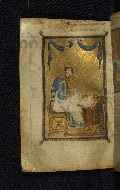Home > Digitized Walters Manuscripts
This document is a tranformation of a TEI P5 XML manuscript description incorporating images. If you have trouble reading special or non-Latin characters on this page, please make sure you have appropriate Unicode fonts installed and an up-to-date web browser.
Walters Ms. W.522, Gospel Book
Browse images (Browse images in a new window) | TEI in XML format
W.522
Gospel Book
Authority name: Eusebius, of Caesarea, Bishop of Caesarea, approximately 260-approximately 340.
This Gospel book was likely created in the capital of the Byzantine Empire, Constantinople, in the eleventh century. The manuscript is remarkable on account of its exceptionally small size, as well as the high quality of its script and miniatures. Its extensive image cycle includes six full-page miniatures, four half-page miniatures, four historiated initials, and marginalia.
Late 11th century CE
Constantinople (Istanbul)
Book
Scriptural
The primary language in this manuscript is Greek, Ancient (to 1453).
Parchment
Lightweight, smooth, high quality parchment; fols. 247-261 slightly lighter in weight and color
Foliation: i+291+i
Two sets of pencil foliation: incorrect earlier foliation in lower right corners of rectos; modern pencil foliation in upper right corners of rectos (followed here)
Formula: 1(2,-2), 2(8), 3(2), 4-10(10), 11(8), 12-16(10), 17(2), 18-25(10), 26(10,-2), 27-28(10), 29(8), 30-32(2,-2), 33-35(10)
Catchwords: None
Signatures: Some traces remain, but mostly trimmed away
Comments: Quires begin on fols. 1(1), 2(2), 10(3), 12(4), 22(5), 32(6), 42(7), 52(8), 62(9), 72(10), 82(11), 90(12), 100(13), 110(14), 120(15), 130(16), 140(17), 142(18), 152(19), 162(20), 172(21), 182(22), 192(23), 202(24), 212(25), 222(26), 231(27), 241(28), 251(29), 259(30), 260(31), 261(32), 262(33), 272(34), 282(35); quires 1, 30, 31, and 32 are singletons
6.7 cm wide by 9.9 cm high
3.8 cm wide by 7.0 cm high
- Columns: 1
- Ruled lines: 25
- Title: Gospel Book
- Hand note: One hand throughout
- Decoration note: Six full-page miniatures; four half-page miniatures; four historiated initials; marginalia
- Title: Letter from Eusebius to Carpianus
- Author: Eusebius, of Caesarea, Bishop of Caesarea, approximately 260-approximately 340.
- Title: Canon tables
- Title: Gospels
- Contents: Fols. 9v-10r: Preface to the Gospel of Matthew; fols. 10r-11r: Chapters list for the Gospel of Matthew; fols. 12r-87v: Gospel of Matthew; fols. 87r-88r: Preface to the Gospel of Mark; fols. 88r-89r: Chapters list for the Gospel of Mark; fols. 90r-138r: Gospel of Mark; fols. 138r-139r: Preface to the Gospel of Luke; fols. 139r-140v: Chapters list for the Gospel of Luke; fols. 142r-228r: Gospel of Luke; fols. 228r-229r: Preface to the Gospel of John; fols. 229v-230r: Chapters list for the Gospel of John; fol. 230r: Verses in praise of the Evangelist John; fols. 231r-291v: Gospel of John incomplete, ends with John 21:3
- Decoration note: Full-page miniatures on fols. 11v, 89v, 141v, and 230v; half-page miniatures accompanied by marginalia and historiated initials on fols. 12r, 90r, 142r, and 231r
fol. 1r:
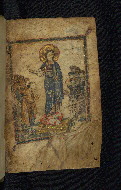
- Title: Christ blessing the Apostles
- Form: Full-page miniature
- Label: Christ blessing the Apostles
- Comment:
The inscription reads "Χ(ριστὸ)ς εὐλογ(ῶν) [τοὺς ἀπο]στόλ[ους]."
The scene known as "Mission of the Apostles" corresponds to John 21:12-19 and is seldom found in Byzantine Gospel illustration. It is not certain that this leaf now occupies its original position: it might have once faced the first page of Acts in a now lost companion volume to W.522.
fol. 1v:
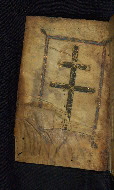
- Title: Cross
- Form: Full-page miniature
- Comment:
The inscription "XXXX" stands for "Χ(ριστὸς) χ(άριν) χ(ριστιανοῖς) χ(αρίζει)" (Christ gives grace to [all] Christians).
A cross placed at the beginning of a book was believed to protect its contents and it owner. This particular form, with two horizontal arms, is known as a patriarchal cross.
fol. 11v:
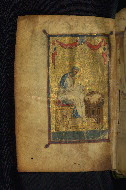
- Title: The Evangelist Matthew writing
- Form: Full-page miniature
- Comment:
The inscription is illegible.
As usual, the Evangelist is shown in the process of writing his Gospel. The curtain, held by a decorative lion's mask above his head, conventionally suggests that he is situated inside a building.
fol. 12r:
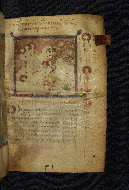
- Title: The Nativity; Abraham, David, and Jesus Christ; the Evangelist Matthew
- Form: Half-page miniature; marginal miniatures; historiated initial "B," 9 lines
- Text: Matthew 1:1-3
- Comment:
The inscription in the upper margin reads "Κυ(ριακὴ) πρὸ τῆς Χ(ριστο)ῦ Γεννή(σεως) τ(ῶν) ῾Αγίων Π(ατέ)ρων" (Sunday of the Holy Fathers, [the Sunday] before Christ's Nativity). (This is the feast day on which the text found on this page is read in church). Next to the figures in the right-hand margin: "῾Ο προπάτωρ ᾿Αβραάμ, ῾Ο πρ(ο)φ(ήτης) Δα(υί)δ, ᾿Ι(ησοὺ)ς Χ(ριστό)ς" (The forefather Abraham, The prophet David, Jesus Christ).
An image of the Nativity (as seen here) sometimes serves as a headpiece for the Gospel of Matthew because the first important liturgical reading in the Gospel of Matthew is the one for Christmas. The image is very worn: most of the paint has flaked, laying bare the preliminary ink drawing. However, the three angels in the upper left corner are still visible, raising their hands in veneration toward the star of Bethlehem (Luke 2:13). In the upper right corner, an angel talks to the shepherds (Luke 2:8-12). On the lower left, Joseph sits deep in thought at the mystery of the Incarnation. Next to him, the newborn Jesus is being washed by his two midwives (the tub resembles a baptismal font). In the center, the Virgin lies on a red bedsheet next to her infant son. The vertical stroke of the initial letter "B" in Matthew 1:1 ("Book of the generation...") is formed by a figure of the Evangelist, pen in hand. He is actually writing the text that we read on the page. This is the very beginning of the Gospel, where Christ's genealogy is recounted. Correspondingly, the three standing figures in the side margin form a sort of abbreviated family tree of the Savior: Abraham above, David in the middle, and Christ at the bottom.
fol. 89v:
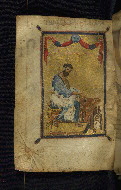
- Title: The Evangelist Mark
- Form: Full-page miniature
- Comment:
The inscription reads "῾Ο ἅγιος Μάρκος" (Saint Mark).
fol. 90r:
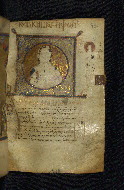
- Title: Jesus Christ; St. John the Baptist; the Evangelist Mark
- Form: Half-page miniature; marginal miniature; historiated initial "A," 6 lines
- Text: Mark 1:1-3
- Comment:
The inscription in the upper margin reads "Κυριακὴ πρὸ τῶν Φώτων" (Sunday before Epiphany [the feast of Christ's Baptism), the day on which the text on this page is read in church. In the side margin: "῾Ο ἅ(γιος) ᾿Ιω(άννης) ὁ Πρ(ό)δ(ρομος)" (Saint John the Forerunner [of Christ]). Next to the initial "A:" "῾Ο ἅ(γιος) Μάρκος" (Saint Mark).
The large miniature portrays "Jesus Christ, the Son of God" (Mark 1:1), while the smaller image in the margin corresponds to Mark 1:4.
fol. 141v:
fol. 142r:
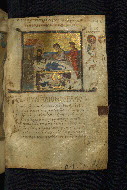
- Title: The birth of St. John the Baptist; the Annunciation to Zechariah; the Evangelist Luke
- Form: Half-page miniature; marginal miniatures; historiated initial "E," 8 lines
- Text: Luke 1:1-3
- Comment:
The inscription in the upper margin reads "Εὐ(αγγέλιον) εἰς τὸ γενέ(σιον) τοῦ Προδρόμου τῆς λειτουργίας" (Gospel [reading] for the liturgy on the [feast day of] the birth of the Forerunner [John]). In the side margin, "Ζαχαρί(ας) ὁ Πρ(ο)φ(ήτης), ῾Ο [...]" (Zechariah the Prophet, The [angel of the Lord]). Next to the initial "E," "῾Ο ἅ(γιος) Λουκᾶς" (Saint Luke).
The scene of John's birth is generally comparable to Christ's Nativity on fol. 12r. Here the infant is being washed in a font-like tub (notice also the golden pitcher from which water is being poured into it). Two women are bringing gifts to Elizabeth on the occasion of her delivery.
fol. 230v:
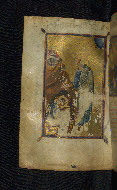
- Title: The Evangelist John and his disciple Prochorus
- Form: Full-page miniature
- Comment:
The inscription reads "[῾Ο ἅ(γιος) ᾿Ιω(άννης) ὁ] Θεολόγος" ([Saint John the] Theologian).
The elderly John is dictating his Gospel to Prochorus, who is seated in a cave on the desert island of Patmos (this scene is more appropriate for the Book of Revelation, but is also used as an author potrait for the Gospel of John). Next to Prochorus is a basket with (probably blank) scrolls of parchment.
fol. 231r:
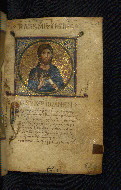
- Title: Jesus Christ; the Evangelist John
- Form: Half-page miniature; historiated initial "I," 10 lines
- Text: John 1:1-5
- Comment:
The inscription in the upper margin reads "Τῇ ἁγίᾳ κ(αὶ) μ(ε)γ(άλῃ) Κυρι(ακῇ) τοῦ Πάσχ(α)" ([Reading] on the holy and great Sunday of Easter). Next to the initial "I," "῾Ο ἅ(γιος) ᾿Ιω(άννης) ὁ Θεολόγος" (Saint John the Theologian).
The Gospel here is preceded by an image of Jesus Christ, the incarnate Word of God, thus illustrating John 1:1.
The binding is not original.
Early twentieth-century; green velvet over wooden boards, bronze clasp; modern parchment flyleaves
Likely created in Constantinople, ca. 1080-1100
Henry Walters, Baltimore, acquired before 1931
Walters Art Museum, 1931, by Henry Walters' bequest
Clark, Kenneth. A Descriptive Catalogue of Greek New Testament Manuscripts in America. Chicago: University of Chicago Press, 1937, pp. 348–350, pl. liv.
Cutler, Anthony. “The Dumbarton Oaks Psalter and New Testament: The Iconography of the Moscow Leaf.” Dumbarton Oaks Papers 37 (1983): 35-45; reproduced in idem. Imagery and Ideology in Byzantine Art. Hampshire: Variorum, 1992, no. viii.
Parpulov, Georgi. “A Catalogue of Greek Manuscripts at the Walters Art Museum.” Journal of the Walters Art Museum 62 (2004): 71-189.
Weyl Carr, Annemarie. “Diminutive Byzantine Manuscripts.” Codices Manuscripti 6 (1980): 130-161, figs. 15-16; reproduced in eadem. Cyprus and the Devotional Arts of Byzantium in the Era of the Crusades. Hampshire: Variorum, 2005, no. v.
Weyl Carr, Annemarie. "Gospel Frontispieces from the Comnenian Period." Gesta 21 (1982): 3-20; reproduced in eadem. Cyprus and the Devotional Arts of Byzantium in the Era of the Crusades. Hampshire: Variorum, 2005, no. iii.
Kavrus-Hoffmann, Nadezhda. "Cataloguing Greek Manuscripts in the Collections of the USA: New Findings and Identifications." In Atsalos, B. and N. Tsironis, eds. Actes du VIe Colloque International de Paléographie Grecque (Drama 21-27 Sept. 2003). Vol. 2. Athens: 2008, pp. 809-814.
Principal cataloger: Parpulov, Georgi R.
Cataloger: Walters Art Museum curatorial staff and researchers since 1934
Editors: Herbert, Lynley; Noel, William
Copy editor: Joyal, Stephanie
Conservators: Owen, Linda; Quandt, Abigail
Contributors: Bockrath, Diane; Emery, Doug; Izer, Emily; Noel, William; Tabritha, Ariel; Toth, Michael B.
The Walters Art Museum
Licensed for use under Creative Commons Attribution-NonCommercial-ShareAlike 3.0 Unported Access Rights, http://creativecommons.org/licenses/by-nc-sa/3.0/legalcode. It is requested that copies of any published articles based on the information in this data set be sent to the curator of manuscripts, The Walters Art Museum, 600 North Charles Street, Baltimore MD 21201.
